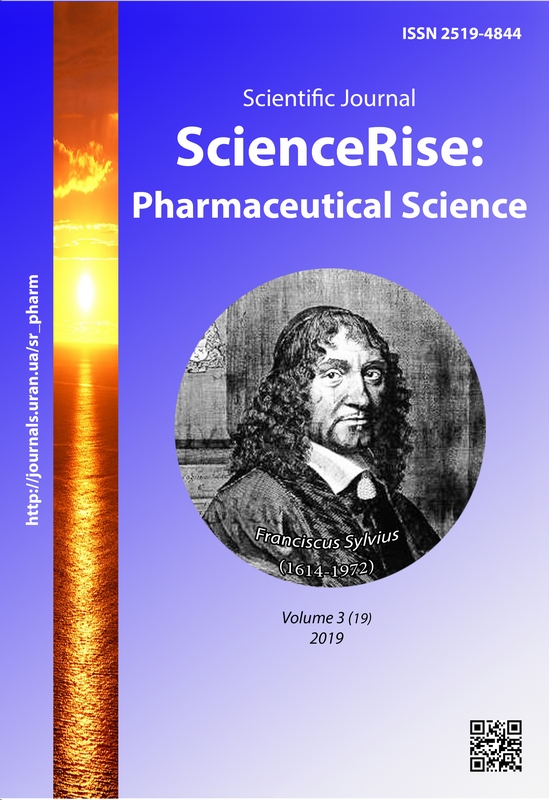Synthesis of potential antiexudative preparations for 2-((4-amino-5-(furan-2-il)-1,2,4-triazole-(4H)-3-yl)-sulfanyl)-N-acetamide series
DOI:
https://doi.org/10.15587/2519-4852.2019.171878Keywords:
synthesis, 4-amino-3-thio-5-(furan-2-yl)-1, 2, 4-triazole, acetamides, alkylation, antiexudative activity, formalin edemaAbstract
Aim. Conduct the purposeful synthesis of new potential biologically active substances of derivatives of 2 - ((4-amino-5- (furan-2-yl) -1,2,4-triazol (4H) -3-yl) -sulfanyl) -N-acetamides and evaluate their anti-exudative activity on the model of formalin edema in rats.
Materials and methods. In this work, standard methods of organic synthesis, physical and chemical methods of proofing the structure of synthesized compounds, elemental analysis, 1H NMR spectroscopy, chromatographic mass spectrometry, and antiexudative activity were studied on the model of formalin edema in rats using a digital plethysmometer.
Results. By alkylation of 2-((4-amino-5-(furan-2-yl))-4H-1,2,4-triazole-3-thione with N-aryl-substituted α-chloroacetamides in ethanol in an alkaline medium, (4-amino-5-(furan-2-yl)-1,2,4-triazole(4H)-3-yl)-sulfanyl)-N-acetamide. After crystallization we obtained white or light yellow crystalline substances with clear melting temperatures. On the model of formalin edema in rats, the antiexudative activity of the newly synthesized 2-((4-amino-5-(furan-2-yl)-1,2,4-triazole (4H) -3-yl) -sulfanil)-N-acetamides was studied. According to the results of the research, a dependence between "chemical structure – antiexudative activity" of the first synthesized compounds was established. The results of experimental studies showed that fifteen out of twenty one compounds showed anti-exudative activity, eight of which exceeded this activity or were at the reference level of sodium diclofenac.
Conclusions. Synthesis of twenty one compounds of 2-((4-amino-5- (furan-2-yl)-1,2,4-triazole(4H)-3-yl)-sulfanyl)-N-acetamide derivatives was carried out and an evaluation of antiexudative activity, the dependence "chemical structure - antiexudative activity" was established. Leading compounds for antiexudative activity were found
References
- Ignatov, Iu. D., Kukes, V. G., Mazurov, V. I. (2010). Klinicheskaia farmakologiia nesteroidnykh protivovospalitelnykh sredstv. Moscow: GEOTAR, 258.
- Karateev, A. E. (2012). Primenenie NPVP: skhematicheskii podkhod. Russkii meditsinskii zhurnal, 25, 1558.
- Demetskaia, A. (2017). Nezhelatelnye lekarstvennye reaktsii: NPVP. Farmatsevt praktik, 2, 28–29.
- Küçükgüzel, Ş. G., Çıkla-Süzgün, P. (2015). Recent advances bioactive 1,2,4-triazole-3-thiones. European Journal of Medicinal Chemistry, 97, 830–870. doi: http://doi.org/10.1016/j.ejmech.2014.11.033
- Ferreira, V. F., da Rocha, D. R., da Silva, F. C., Ferreira, P. G., Boechat, N. A., Magalhães, J. L. (2013). Novel 1H-1,2,3-, 2H-1,2,3-, 1H-1,2,4- and 4H-1,2,4-triazole derivatives: a patent review (2008 – 2011). Expert Opinion on Therapeutic Patents, 23 (3), 319–331. doi: http://doi.org/10.1517/13543776.2013.749862
- Kharb, R., Sharma, P. C., Yar, M. S. (2010). Pharmacological significance of triazole scaffold. Journal of Enzyme Inhibition and Medicinal Chemistry, 26 (1), 1–21. doi: http://doi.org/10.3109/14756360903524304
- Tariq, S., Kamboj, P., Alam, O., Amir, M. (2018). 1,2,4-Triazole-based benzothiazole/benzoxazole derivatives: Design, synthesis, p38α MAP kinase inhibition, anti-inflammatory activity and molecular docking studies. Bioorganic Chemistry, 81, 630–641. doi: http://doi.org/10.1016/j.bioorg.2018.09.015
- Mousa, T. H., Elia, A. N. (2015). Design, synthesis and preliminary pharmacological evaluation of new possible non-steroidal anti-inflammatory agents having the 5-(methylsulfonyl)-1,2,4-triazole-3-amine pharmacophore. Der Pharma Chemica, 7 (9), 279–293.
- Shepeta, Y. L., Lelyukh, M. I., Zimenkovsky, B. S., Lesyk, R. B. (2016). Synthesis of novel 4H-1,2,4-triazole-3-thiol derivatives with 2-(2,6-dichlorophenylamino)benzyl fragment in molecules and their anti-inflammatory activity. Current Issues in Pharmacy and Medicine: Science and Practice, 1 (20), 18–25. doi: http://doi.org/10.14739/2409-2932.2016.1.61103
- Coşkun, G., Djikic, T., Hayal, T., Türkel, N., Yelekçi, K., Şahin, F., Küçükgüzel, Ş. (2018). Synthesis, Molecular Docking and Anticancer Activity of Diflunisal Derivatives as Cyclooxygenase Enzyme Inhibitors. Molecules, 23 (8), 1969. doi: http://doi.org/10.3390/molecules23081969
- Navidpour, L., Shafaroodi, H., Abdi, K., Amini, M., Ghahremani, M. H., Dehpour, A. R., Shafiee, A. (2006). Design, synthesis, and biological evaluation of substituted 3-alkylthio-4,5-diaryl-4H-1,2,4-triazoles as selective COX-2 inhibitors. Bioorganic & Medicinal Chemistry, 14 (8), 2507–2517. doi: http://doi.org/10.1016/j.bmc.2005.11.029
- Cai, H., Huang, X., Xu, S., Shen, H., Zhang, P., Huang, Y. et. al. (2016). Discovery of novel hybrids of diaryl-1,2,4-triazoles and caffeic acid as dual inhibitors of cyclooxygenase-2 and 5-lipoxygenase for cancer therapy. European Journal of Medicinal Chemistry, 108, 89–103. doi: http://doi.org/10.1016/j.ejmech.2015.11.013
- Jiang, B., Huang, X., Yao, H., Jiang, J., Wu, X., Jiang, S. et. al. (2014). Discovery of potential anti-inflammatory drugs: diaryl-1,2,4-triazoles bearing N-hydroxyurea moiety as dual inhibitors of cyclooxygenase-2 and 5-lipoxygenase. Organic & Biomolecular Chemistry, 12 (13), 2114–2127. doi: http://doi.org/10.1039/c3ob41936c
- Syrovaya, A. O., Chalenko, N. N., Demchenko, A. M. (2016). The Synthesis of potential anti-inflammatory substances among 4-amino-5-(pyridin-4-yl)-1,2,4-triazole(4H)-3-yl-thioacetamides and their chemical modification. Der Pharma Chemica, 8 (21), 17–21.
- Syrovaya, A., Chalenko, N., Bezuglyi, P., Demchenko, A. (2017). The synthesis of 4-amino -5-(pyridin-2(3)-Yl) -1,2,4-triazole (4H)-3-ylthio acetamide derivatives as potential anti-inflammatory substances. ScienceRise: Pharmaceutical Science, 1 (5), 40–44. doi: http://doi.org/10.15587/2519-4852.2017.93332
- Parchenko, V. V., Yerokhin, V. Ye., Panasenko, O. I., Knysh, Ye. H. (2010). Syntez, peretvorennia, fizyko-khimichni vlastyvosti 4-alkil-, aryl-ta 4-aminopokhidnykh 1,2,4-triazol-3-tioliv iz zalyshkamy frahmentiv furanu. Zaporozhskyi medytsynskyi zhurnal, 12 (4), 83–87.
- Xu, S., Rouzer, C. A., Marnett, L. J. (2014). Oxicams, a class of nonsteroidal anti-inflammatory drugs and beyond. IUBMB Life, 66 (12), 803–811. doi: http://doi.org/10.1002/iub.1334
- Rani, P., Pal, D., Hegde, R. R., Hashim, S. R. (2014). Anticancer, Anti-Inflammatory, and Analgesic Activities of Synthesized 2-(Substituted phenoxy) Acetamide Derivatives. BioMed Research International, 2014, 1–9. doi: http://doi.org/10.1155/2014/386473
- Saidov, N. B., Kadamov, I. M., Georgiyants, V. A., Taran, A. V. (2014). Planning, Synthesis, and Pharmacological Activity of Alkyl Derivatives of 3-Mercapto-4-Phenyl-5-Arylaminomethyl-1,2,4-Triazole-(4H). Pharmaceutical Chemistry Journal, 47 (11), 581–585. doi: http://doi.org/10.1007/s11094-014-1011-0
- Way2Drug – main. (Prediction of Activity Spectra for Substances) PASS. Available at: http://www.way2drug.com/PASSonline/
- Nadkarni, B., Kamat, V., Khadse, B. (2011). Synthesis and Anthelmintic Activity of 3,6-Disubstituted-7H-s-triazolo(3,4-b) (1,3,4) thiadiazines. Arzneimittelforschung, 51 (7), 569–573. doi: http://doi.org/10.1055/s-0031-1300081
- Drohovoz, S. M., Zupanets, I. A., Mokhort, M. A. (2001). Eksperymentalne (doklinichne) vyvchennia farmakolohichnykh rechovyn, yaki proponuiutsia yak nesteroidni protyzapalni zasoby. Doklinichni doslidzhennia likarskykh zasobiv. Kyiv: Avitsenna, 242–306.
- Rybolovlev, Iu. R., Rybolovlev, R. S. (1979). Dozirovanie veshchestv dlia mlekopitaiushchikh po konstantam biologicheskoi aktivnosti. Doklady AN SSSR, 6, 1513–1516
- Stefanov, O. V. (Ed.) (2001). Doklinichni doslidzhennia likarskykh zasobiv. Kyiv: Avitsenna, 527.
Downloads
Published
How to Cite
Issue
Section
License
Copyright (c) 2019 Natalia Chalenko, Anatoly Demchenko, Ganna Syrova

This work is licensed under a Creative Commons Attribution 4.0 International License.
Our journal abides by the Creative Commons CC BY copyright rights and permissions for open access journals.








